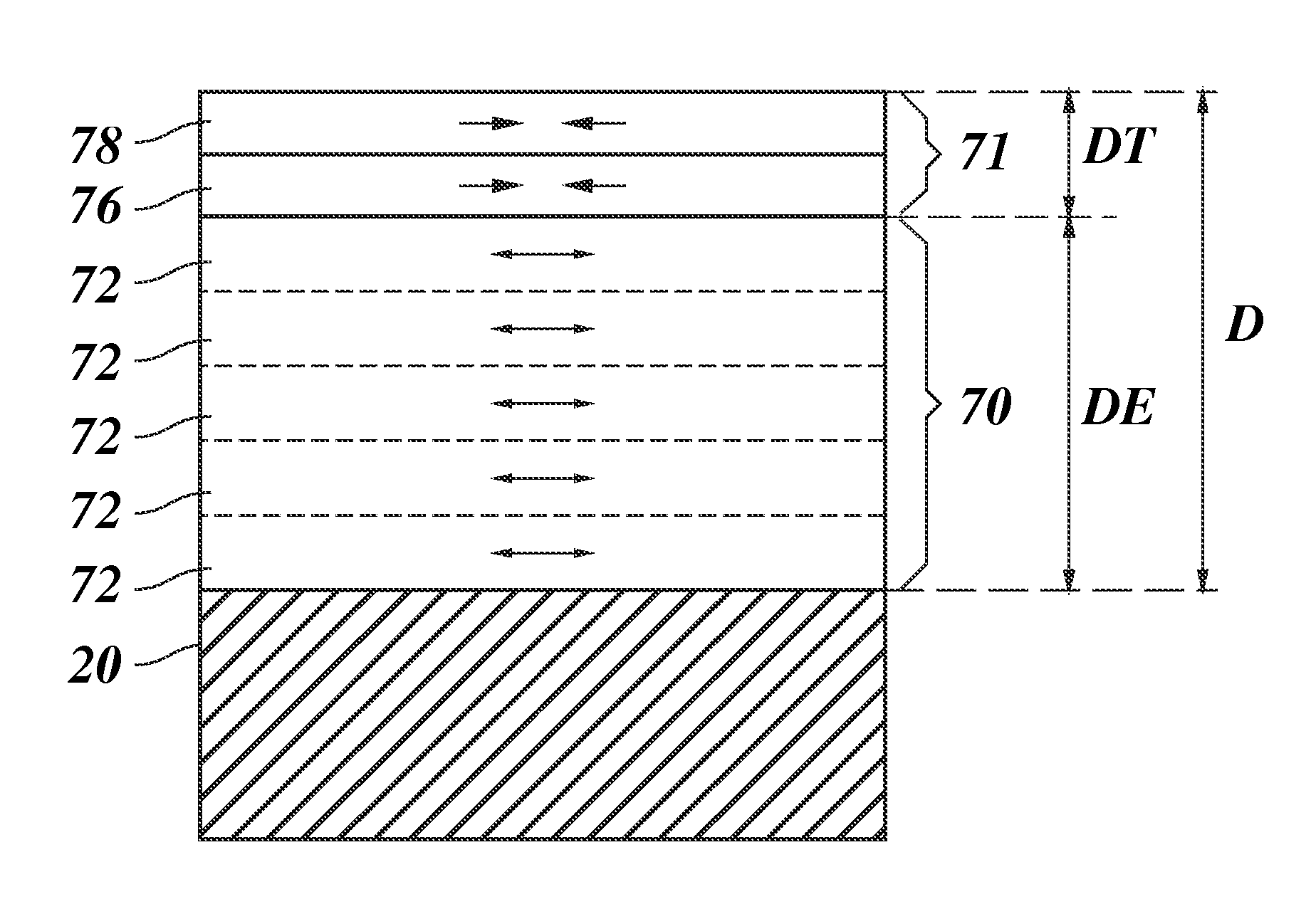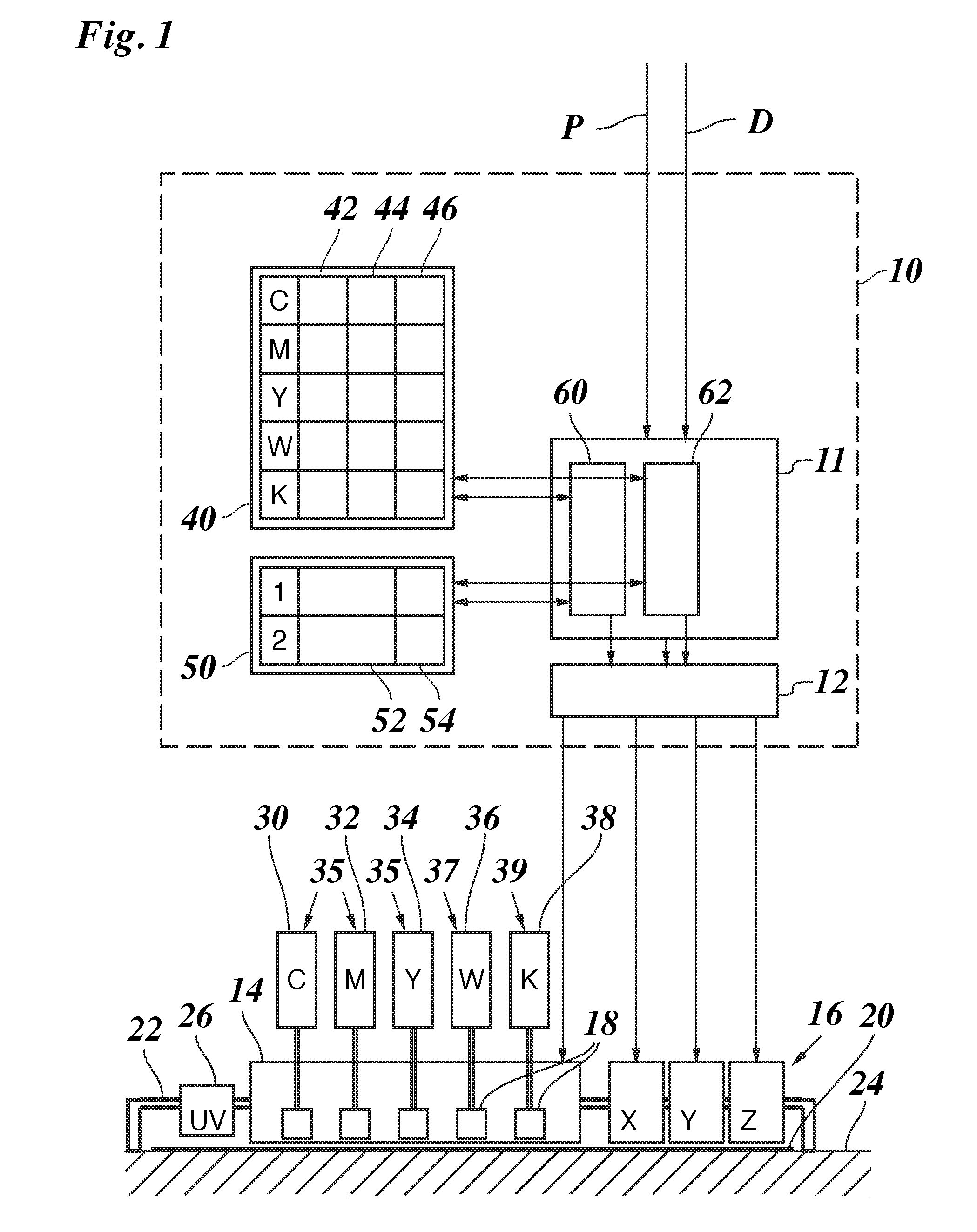Printing system and method of printing a multilayer structure using radiation curable ink
a printing system and multi-layer structure technology, applied in the field of printing systems, can solve the problems of deformation, detachment of printed structures, and special mechanical stress, and achieve the effects of minimizing expansion/shrinkage mechanical stress, and improving thermal expansion coefficient differences
- Summary
- Abstract
- Description
- Claims
- Application Information
AI Technical Summary
Benefits of technology
Problems solved by technology
Method used
Image
Examples
first example
[0051]In a first example, a structure having a target thickness D of 0.2 mm is printed on a receiving material 20 in the form of thin polyester film having a thickness of 0.1 mm (Océ polyester MC500).
[0052]The structure comprises an elevation layer 70 and a top layer 71. The elevation layer 70 comprises one or more sub-layers 72, which are schematically shown in FIG. 2. The top layer 71 comprises a white cover layer 76, which completely covers the top surface of the elevation layer 70, and an image layer 78 reproducing image data P. A thickness DT of the top layer 71 is determined by the average thickness of the image layer 78 and the e.g. constant thickness of the optional white cover layer 76.
[0053]The white cover layer 76 is printed using the first ink 37 (W). The image layer 78 is printed using the first inks 35 (C, M, Y) in accordance with the image information P. The inks 35, 37 (C, M, Y, W) used for the top layer 71 have substantially the same curing expansion / shrinkage prope...
second example
[0070]In a second example, the proportion may be fine tuned to counterbalance the expansion / shrinkage properties of the inks even better. For example, the proportion determining unit 62 may determine a proportion of 22.4% to 77.6% for the amount of the second ink K to the amount of the first inks for the elevation layer. That is, the elevation layer 70 contains 77.6% Océ IJC255 ink and 22.4% Océ IJC256 ink. Therefore, the expansion of the elevation layer 70 is (0.776×−0.4%)+(0.224×2%)=0.1376%.
[0071]As above, the shrinkage of the top layer 71 is 1.0×−0.4%=−0.4%.
[0072]The resulting total curing expansion of the printed structure is: (0.15 / 0.2×0.1376%)+(0.05 / 0.2×−0.4%)=0.003%.
[0073]For example, in order to achieve the above proportion, the raster image processor 12 may use a reduced dot density of 87% for the first inks 35, 37 (C,M,Y,W), and the normal dot density of 100% for the second ink 39 (K) for printing the sub-layers 72 (steps S6, S7).
[0074]As the curing expansion / shrinkage pro...
third example
[0077]FIG. 7 shows a third example. A multilayer structure is printed on a receiving material 20. In this example, the combined effects of the curing expansion / shrinkage properties and thermal expansion of the inks is minimized for a target temperature of e.g. 70° C. For example, the target temperature is a temperature within a usage temperate range of the resulting product. For example, the receiving material 20 is polycarbonate having a linear thermal expansion coefficient of 0.07 mm / m K.
[0078]For example, the linear thermal expansion coefficients of the inks may be measured using e.g. a test strip prepared as explained above with FIG. 6. For example, the linear thermal expansion coefficient of the first ink, Océ IJC255, is: 0.15 mm / m K. The linear thermal expansion coefficient of the second ink, IJC256, is: 0.22 mm / m K.
[0079]Thus, the thermal expansion of the inks relative to the polycarbonate, between a printing temperature of e.g. 40° C. and a target temperature of 70° C. is: (...
PUM
| Property | Measurement | Unit |
|---|---|---|
| height | aaaaa | aaaaa |
| height | aaaaa | aaaaa |
| height | aaaaa | aaaaa |
Abstract
Description
Claims
Application Information
 Login to View More
Login to View More - R&D
- Intellectual Property
- Life Sciences
- Materials
- Tech Scout
- Unparalleled Data Quality
- Higher Quality Content
- 60% Fewer Hallucinations
Browse by: Latest US Patents, China's latest patents, Technical Efficacy Thesaurus, Application Domain, Technology Topic, Popular Technical Reports.
© 2025 PatSnap. All rights reserved.Legal|Privacy policy|Modern Slavery Act Transparency Statement|Sitemap|About US| Contact US: help@patsnap.com



